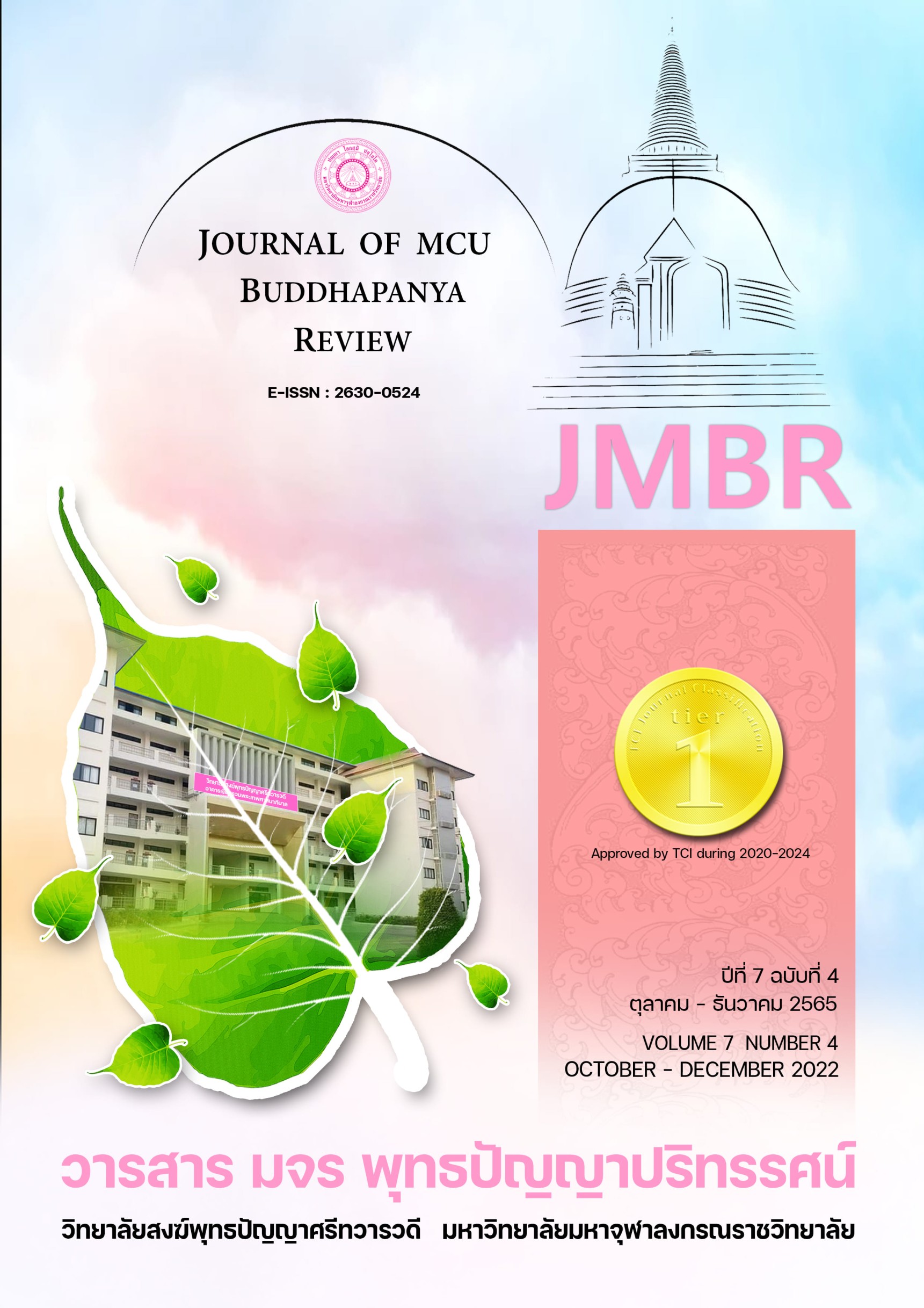การศึกษาแผนการจัดการเรียนรู้ตามแนวคิดการคิดอย่างมีศิลปะ ในรายวิชาศิลปะพื้นฐาน เพื่อส่งเสริมการสร้างสรรค์ผลงานและการรับรู้สุนทรียภาพ สำหรับนักเรียนชั้นมัธยมศึกษาปีที่ 5
คำสำคัญ:
แนวคิดการคิดอย่างมีศิลปะ, การสร้างสรรค์ผลงาน, การรับรู้สุนทรียภาพบทคัดย่อ
บทความวิจัยนี้มีเป็นการวิจัยเชิงทดลอง (Experimental Research) ใช้แนวคิดทฤษฎีศิลปศึกษา ร่วมกับรูปแบบการเรียนรู้การคิดเชิงศิลปะ Artful Thinking และ ทฤษฎีพัฒนาสุนทรียภาพของ Michael J. Parson เป็นกรอบการวิจัย กลุ่มตัวอย่างที่ใช่ในการวิจัย คือ นักเรียนชั้นมัธยมศึกษาปีที่ 5/2 โรงเรียนปากเกร็ด จังหวัดนนทบุรี จำนวน 26 คน โดยผู้วิจัยได้มาจากการสุ่มอย่างง่าย โดยใช้ห้องเรียนเป็นหน่วยสุ่ม เครื่องมือที่ใช้ในการวิจัยคือ 1) แผนการเรียนรู้ตามแนวคิดการคิดอย่างมีศิลปะ 2) แบบประเมินการรับรู้สุนทรียภาพ 3) แบบประเมินการสร้างผลงานศิลปะ ข้อมูลสถิติที่ใช้ในการวิเคราะห์ประกอบด้วย 1) การหาค่าประสิทธิภาพของแผนกิจกรรมการเรียนรู้การจัดการเรียนรู้ตามแนวคิดการคิดอย่างมีศิลปะ โดยใช้สูตรประสิทธิภาพE1/E2 2) ค่าสถิติที่ใช้ในการหาระดับการรับรู้สุนทรียภาพและระดับการสร้างผลงานศิลปะของนักเรียนชั้นมัธยมศึกษาปีที่ 5 ได้แก่ ค่าร้อยละ(%) ค่าเฉลี่ย() วิเคราะห์เนื้อหา(Content Analysis) และประเมินความสอดคล้องด้วยค่า Index Item Objective Congruence : IOC ) ผลการวิจัยพบว่า
- ผลการประเมินประสิทธิภาพแผนการจัดการเรียนรู้ตามแนวคิดการคิดอย่างมีศิลปะ มีค่าดัชนีความสอดคล้องของเครื่องมือ (Index Item Objective Congruence: IOC) ซึ่งมีค่า IOC = 0.67 - 1.00 อยู่ในระดับคุณภาพที่ผู้เชี่ยวชาญเห็นด้วยมาก
- ผลคะแนนการสร้างผลงานศิลปะมีผลประเมินระหว่างการจัดกิจกรรมการเรียนรู้ (E1) ได้ค่าประสิทธิภาพ = ร้อยละ 92.09 และผลหลังการประเมินหลังการจัดกิจกรรมการเรียนรู้ (E2) ได้ค่าประสิทธิภาพ = 93.90 ได้ผลสูงกว่าเกณฑ์ที่ตั้งไว้ คือ 90/90
- ผลการประเมินการรับรู้สุนทรียภาพของนักเรียนชั้นมัธยมศึกษาปีที่ 5 หลังการจัดกิจกรรมการเรียนรู้ตามแนวคิดการคิดอย่างมีศิลปะอยู่ในระดับ 5 ความเป็นตัวตน (Autonomy) เป็นไปตามสมมุติฐานที่ตั้งไว้
เอกสารอ้างอิง
Ministry of Education. (2010). Basic Education Core Curriculum 2008. 3rd edition. Bangkok: Chum Chum Printing House, Agricultural Cooperative of Thailand Limited.
Ministry of Education. (2011). Guidelines for organizing learning activities for development. Analytical thinking skills. Bangkok: Office of Academic Affairs and Basic Education Standards.
Keerati Boonchuea. (1979). Encyclopedia of Philosophy. Bangkok: Thai Wattana Panich.
Chalong Soonthornnon. (2015). Aesthetics and Visual Arts. Samut Sakhon: App Printing Group.
Thanit Pianmaneewong. (2014). "Development of a self-skills practice in visual elements. and artistic elements to create art works for students at the level high school St. Gabriel School, Bangkok." Academic Journal Veridian E-Journal, 7, 2: 1497-1508.
Tarin Klinkasorn. (2011). "The effect of promoting aesthetic experiences through activities in an art museum towards the aesthetics of elementary school students." Master of Education Thesis Department of Art Education, Department of Art, Music and Dramatic Arts Studies, Faculty of Education, Chulalongkorn University.
Bundit Tipakorn. (2007). Development of faculty members in higher education institutions. In Paitoon Sinlarat (Editor), Professional Lecturer: Concepts, Tools and Development. Bangkok: Chulalongkorn University Printing House.
Malichat Eua-Anan. (2002). Reformed art education. 2nd edition, Bangkok: Chulalongkorn University Press.
Mariam Nilphan. (2014). Educational research methods. Print No.8. Nakhon Pathom: Silpakorn University Printing House.
Wisoot Phongern. (2013). Art for Children. Nakhon Pathom: Silpakorn University. Sanam Chandra Palace Campus.
Sitthinan Rungtaweesup and Wisoot Phongern. (2018). "Activity Development Critical art to promote aesthetics and valuation for students. Grade 5, "Graduate School Journal" Suan Dusit University, 14, 3 (September – December).
Suchart Sutthi. (1992). A Manual for Teaching Visualization: Fundamentals of Visual Arts Criticism. Bangkok: O.S. Printing House.
Suphalak Wongnoh. (2015). "The result of the arts and entertainment education activities at Aesthetic promotion for children aged 7-9." Journal of OJED, 10, 2: 471 - 483.
Aree Suthiphan. (1992). Popular Arts. Bangkok: Odeon Store.
Clark, G., Day, M. D., and Greer, W. D. (1987). "Discipline-Based Art Education : Becoming students of Art." Journal of Aesthetic Education, 21, 2: 135-136.
D’Onofrio, A., and Nodine, C. F. (1981). "Children’s Responses to paintings." Studies in Art Education, 23, 1: 14-23.
Elena, M. T., and Irina, A. P. (2016). "The influence of modern adolescents’ vision of life on their perception of art." International Journal of environmental & science Education, 11, 18: 10751-10759.
Osborne, H. (1970-74). Aesthetics in the modern world The Hague : Mouton.
Parsons, M. J. (1987). How We Understand Art: A Cognitive Developmental Account of Aesthetic Experience. New York: Cambridge University.
Torshilova, E. M., and Polosukhina, I. A. (2016). "The influence of modern adolescents’ vision of life on their perception of art." International Journal of environmental & science Education, 11, 18: 10751 - 10759.
ดาวน์โหลด
เผยแพร่แล้ว
รูปแบบการอ้างอิง
ฉบับ
ประเภทบทความ
สัญญาอนุญาต
ลิขสิทธิ์ (c) 2022 วารสาร มจร พุทธปัญญาปริทรรศน์

อนุญาตภายใต้เงื่อนไข Creative Commons Attribution-NonCommercial-NoDerivatives 4.0 International License.



